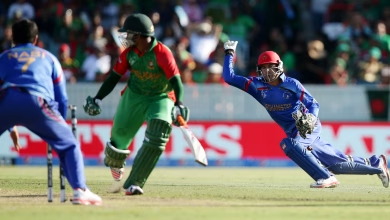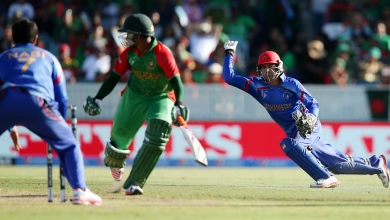Deadliest Bouncer in Cricket History
The Deadliest Bouncer in Cricket History: A Deep Dive into the Infamous Delivery
Cricket, often referred to as a “gentleman’s game,” is a sport that thrives on sportsmanship, skill, and respect. However, the intensity of the game has sometimes led to moments of shocking violence, where players find themselves confronting the deadliest of deliveries. Among these, the bouncer—a fast, aggressive delivery aimed at the batsman’s head or chest—has gained notoriety for its potential to cause serious harm. A bouncer, when bowled with extreme pace and precision, can change the course of a game, and sometimes even a player’s career.
But while bouncers are an integral part of fast bowling, some have been more than just a delivery—they’ve been a moment of terror, a life-threatening threat to the batsman, and a deadly reminder of the dangers of the sport.
One particular bouncer stands out in cricket history as perhaps the deadliest and most horrifying: the bouncer bowled by Shane Warne to Steve Waugh in the 1997 Adelaide Test. This bouncer, which was the epitome of skill and sheer force, not only left a lasting impact on the game but also remains a potent symbol of the brutal side of fast bowling.
In this article, we explore the bouncer’s significance in cricket, the context of this particular delivery, its aftermath, and why it is still regarded as one of the most dangerous moments in the sport’s history.
The Bouncer: The Art of Aggressive Fast Bowling
Before diving into the infamous bouncer, it is important to understand the role of the bouncer in the art of fast bowling. A bouncer is a short-pitched delivery that rises steeply toward the batsman’s head or upper body. The objective is clear: to intimidate, unsettle, and, if possible, force a mistake. A well-executed bouncer, delivered at high speed, can not only cause physical harm but can also disrupt a batsman’s rhythm and concentration.
Fast bowlers often use bouncers as a psychological weapon. They are designed to take advantage of the batsman’s fear of being hit, forcing them into making rash decisions. But not all bouncers are the same. Some are meant to fly over the batsman’s head, some are aimed at the body, while others—more deadly—target the head. It’s in these moments when cricket’s seemingly gentle nature reveals a brutal reality.
The Infamous Delivery: Shane Warne vs Steve Waugh, 1997 Adelaide Test
In December 1997, during the second Test of the 1997 Ashes series, Australia was taking on England in a match at the Adelaide Oval. On the third day of the match, Australia’s legendary spinner Shane Warne delivered a bouncer that would go down in history as one of the most terrifying and deadly balls ever bowled.
It all started when Steve Waugh, an Australian batting great, came to the crease. At that time, Waugh was known for his resilience and unshakable temperament. However, the presence of Warne and his menacing deliveries, including this particular bouncer, would force Waugh to face one of his most challenging moments in his cricketing career.
As the ball was released from Warne’s hand, it travelled at an incredible pace—around 90 mph—and pitched just short of a length. It rose sharply towards Waugh’s head, who instinctively tried to duck under it. But in a cruel twist of fate, the ball hit the brim of Waugh’s helmet, knocking him to the ground. The sheer speed and force of the bouncer left Waugh momentarily dazed, and the crowd gasped in horror.
This wasn’t just any bouncer. Warne had bowled a delivery that targeted Waugh’s head in a highly calculated and aggressive manner. The ball’s trajectory, the pace, and the sharp bounce were all indicative of Warne’s mastery of fast bowling. In a game where technique, precision, and athleticism are paramount, Warne’s bouncer showed just how ruthless the art of fast bowling could be.
The Aftermath: Waugh’s Recovery and Warne’s Brutality
Waugh, although rattled, managed to recover and continued his innings. However, the incident left a lasting scar. The bouncer had not only rattled Waugh physically but had also brought into focus the immense danger associated with fast bowling. In the aftermath, there was a collective realization that the bouncer—despite its occasional use for tactical purposes—could be deadly.
The incident also raised questions about helmet safety. The helmet had been introduced to protect batsmen, but incidents like these highlighted how crucial it was for players to wear protective gear, especially when facing hostile fast bowling. Helmets, while offering protection, could only do so much when confronted with high-speed deliveries aimed directly at the head.
Warne, known for his wit and calculated aggression, later remarked on the delivery, admitting that the bouncer had been part of a wider strategy to unsettle Waugh. The Australian spin legend believed in using every weapon in his arsenal, and while he had made his name as a leg-spinner, this bouncer showed his diversity as a bowler.
The Significance of the Bouncer in the Modern Game
In modern cricket, bouncers have become an essential part of the fast bowler’s toolkit. Players like Brett Lee, Shane Bond, Jasprit Bumrah, and Mitchell Johnson have all used bouncers to unsettle opposition batsmen. The tactic has become more frequent, and batsmen are now forced to play the bouncer more often than ever before.
However, the infamous Warne-Waugh bouncer remains symbolic not just because of the player involved but because it represents a point in cricket history where the nature of the game shifted. The bouncer had always been a tactic, but as the game became more commercialized and players started facing bowlers at even higher speeds, the danger of the bouncer increased.
The death of Phillip Hughes in 2014, caused by a bouncer from Sean Abbott, highlighted the true risks associated with high-speed deliveries aimed at the head. This tragic incident forced the cricketing world to revisit safety protocols and protective gear, including neck guards and improved helmet designs, to ensure that players were better shielded from the dangerous impacts of a fast, hostile bouncer.
The Deadliest Bouncers in Cricket: A Broader Context
While Warne’s bouncer to Waugh remains iconic, it is far from the only terrifying delivery in the history of the sport. Several instances involving other fast bowlers have cemented their places in cricketing folklore. Some of the most notable examples include:
West Indies’ Fast Bowling Legacy: The 1970s and 1980s saw the West Indian pace quartet, Andy Roberts, Malcolm Marshall, Joel Garner, and Curtly Ambrose, terrorize batsmen with bouncers. The West Indies, known for their speed and aggressive bowling, dominated international cricket with their relentless barrage of bouncers.
“The Bodyline Series” (1932-33): One of the most infamous tactics in cricket history was the English team’s “Bodyline” bowling strategy against Australia. Fast bowlers like Harold Larwood were instructed to bowl bouncers aimed directly at the Australian batsmen’s bodies in an attempt to break their defense. This strategy was highly controversial and led to heated debates about fairness and sportsmanship.
Shane Warne’s Rivals: While Warne’s bouncer to Waugh was famous, Shane Warne himself faced a few intimidating bouncers. One such delivery came from Curtly Ambrose during the 1995 Antigua Test, where Ambrose targeted Warne with a brutal bouncer that almost hit him on the head.
Mitchell Johnson vs. England (2013-14 Ashes): In the 2013-14 Ashes, Mitchell Johnson became the player who terrorized England with bouncers. His aggressive spell of fast bowling, targeting the England batsmen’s heads and bodies, played a key role in Australia’s 5-0 series whitewash.
Conclusion: The Deadly Side of Fast Bowling
Bouncers have always been an essential part of fast bowling, a tactic meant to instill fear and unsettle batsmen. The delivery by Shane Warne to Steve Waugh remains etched in cricketing history as one of the most terrifying moments in the sport. It is a reminder of the fine line between aggression and danger, and of the extreme risks that players face when they step onto the field.
While the evolution of protective gear has made the game safer, the dangers of facing fast bowling—especially a deadly bouncer—remain a crucial part of cricket’s allure. This brutal side of the game serves as a reminder that, behind the skill, there is always a certain level of peril that makes cricket one of the most intense and thrilling sports to watch.


